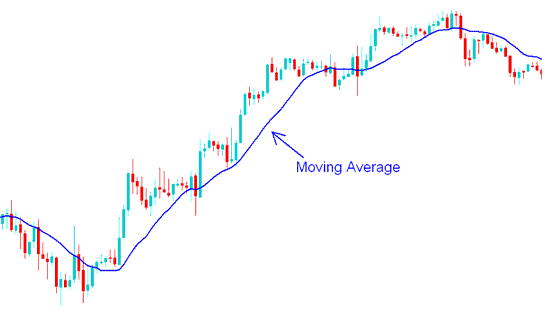20 Period Moving Average Strategy - 50 Period Moving Average Strategy - 100 Period Moving Average Strategy
A trader can choose a moving average to trade with based on the chart time frame that they use for trading; a trader might choose the moving average to trade 1 minute chart, 1 hour chart, 4 hour chart, day chart or even weekly chart.
A trader can also select to average the closing price, opening price or median price - when choosing a MA.
Moving average indicator is oftenly used to measure strength of trends. Data of the moving average is precise & its output as a line can be customized to the preferences of a trader.
Using the moving average indicator is one of the basic forex strategies to generate buy & sell signals which are used to trade in direction of trend, since the moving average indicator is a lagging indicator and a trend following indicator. The Moving average indicator as a lagging indicator means that moving average will tend to give late signals as opposed to leading indicators. However, the MAs indicator as a lagging indicator gives more accurate trading signals and is less prone to forex whipsaws compared to forex leading indicators.
Traders choose the moving average period to use when trading with this moving average indicator depending on the type of forex method they use: short term, medium term & long term.
- Short term trading: 20 Period MA Strategy
- Medium term trading: 50 Period Moving Average Strategy
- Long term trading: 100 Period MA Strategy
The period of the moving average in can be measured in 1 minute chart, 1 hour chart, 4 hour chart, day chart or even weekly chart. For our forex strategy example we will use 1 hour chart period.
Short term moving averages are sensitive to price action & can identify trend signals faster than the long term moving averages. Shorter term moving averages are also more prone to forex whipsaws compared to long term moving averages.
Long term moving averages help to avoid whipsaw fakeouts, but are slower in identifying new trends and reversals.
Because long-term moving averages calculate average using more price data points, the long term moving average does not reverse as fast as a short term moving average & it is slow to catch the changes or reversals in the market trend. However the longer term moving average is better when the market trend stays in force for a longer time.
The task of a trader is to find a moving average period which will spot trends as early as possible while at the same time avoiding fake out signals - forex whipsaws. As a trader you will need to first test different moving average periods before deciding which moving average period is best suited for your style method based on the results of the testing that you'll do using different moving averages.
Moving Average Period Strategy - Forex Moving Average Strategy
Moving average indicator is a trend following indicator that is used by traders for three things:
- Identifying the beginning of a new trend
- Measure the sustainability of new trend
- Identify the ending of a trend and signal a trend reversal
The moving average indicator is used to smooth out the volatility of price action. The moving average indicator is an overlay indicator and it is superimposed on the price chart.
On the moving average example below - the blue line represents a 20 period moving average, which acts to smooth the volatility of price action.

20 Period Moving Average Strategy - 50 Period Moving Average Strategy - 100 Period Moving Average Strategy
Calculation of the Moving Average Price Period
The moving average is calculated as an average of price using the recent most price data point - forex periods.
If a moving average uses the 20 period to calculate the moving average then it is known as to as a 20 period moving average, because most traders use the day chart as the standard price period we shall just refer to the moving average as the 20 day moving average.
To calculate the 20 day moving average the price of the last 20 days is averaged - & the average is then updated constantly after every new price period closes. So after each new price period close is formed the average is then re-calculated afresh using the most recent 20 price periods, that is why this trading indicator is called a moving average because the average is constantly moving when price data is updated and re-calculated.


